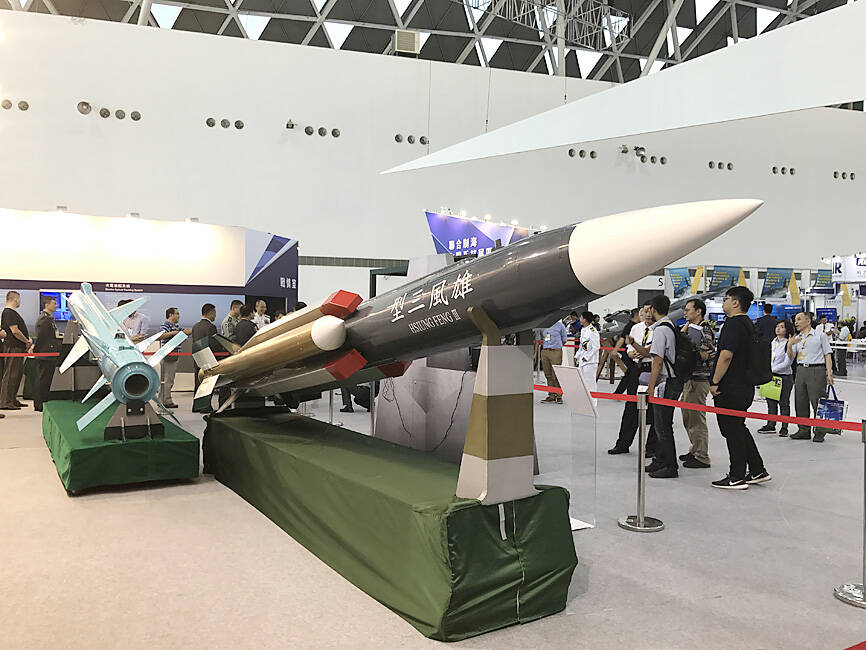A NT$16.9 billion (US$534.93 million) project to upgrade the military’s missile defense systems would be completed this year, allowing the deployment of at least 100 long-range Hsiung Sheng missiles and providing more deterrence against China, military sources said on Saturday.
Hsiung Sheng missiles are an extended-range version of the Hsiung Feng IIE (HF-2E) surface-to-surface cruise missile, and are believed to have a range of up to 1,200km, which would allow them to hit targets well inside China.
They went into mass production in 2022, the sources said.

Photo: Hung Chen-hung, Taipei Times
The project is part of a special budget for the Ministry of National Defense aimed at improving naval and air combat capabilities, and while the project’s time line was four years, the majority of production would be completed this year, they said.
Two other versions of the HF-2E missile system are already in use by the air force. They are classified as either Type A or Type B, with Type A having a range of 500km and Type B having a range of 1,000km due to their different propulsion systems.
The military developed a new turbofan engine codenamed Kunpeng (鯤鵬) for the Type B missile, which is able to fly farther while conserving fuel, one source said.
The Type A missile was first tested in 2004, and the Type B in 2007, the source said, adding that both have since been in regular mass production and supplied to the air force’s missile brigade.
“The new longer-range surface-to-surface cruise missile ... looks similar to the American Tomahawk,” the source said.
Although the ministry has not specifically disclosed the range of the Hsiung Sheng, sources have put it at up to 1,200km.
A report submitted to the Legislative Yuan in April 2022 revealed that the Hsiung Sheng can carry high-explosive and fragmentation warheads.
“It can be used to conduct counter-attack operations against the enemy’s command posts, bunkers and airport runways,” the source said.
A previous report from the ministry to the Legislative Yuan also said that the Hsiung Sheng shares a production line with the surface-to-air variants of the Hsiung Feng IIE.
Although the military has not announced expected production capacity, a new missile production plant at the Chungshan Institute of Science and Technology would likely allow more than 130 of the new missiles to be produced annually, the source said.
“When deployed alongside existing sea and air defense missile systems, the extended-range missile would improve overall combat readiness significantly,” the source said.

TRAGEDY STRIKES TAIPEI: The suspect died after falling off a building after he threw smoke grenades into Taipei Main Station and went on a killing spree in Zhongshan A 27-year-old suspect allegedly threw smoke grenades in Taipei Main Station and then proceeded to Zhongshan MRT Station in a random killing spree that resulted in the death of the suspect and two other civilians, and seven injured, including one in critical condition, as of press time last night. The suspect, identified as a man surnamed Chang Wen (張文), allegedly began the attack at Taipei Main Station, the Taipei Fire Department said, adding that it received a report at 5:24pm that smoke grenades had been thrown in the station. One man in his 50s was rushed to hospital after a cardiac arrest

SAFETY FIRST: Double the number of police were deployed at the Taipei Marathon, while other cities released plans to bolster public event safety Authorities across Taiwan have stepped up security measures ahead of Christmas and New Year events, following a knife and smoke bomb attack in Taipei on Friday that left four people dead and 11 injured. In a bid to prevent potential copycat incidents, police deployments have been expanded for large gatherings, transport hubs, and other crowded public spaces, according to official statements from police and city authorities. Taipei Mayor Chiang Wan-an (蔣萬安) said the city has “comprehensively raised security readiness” in crowded areas, increased police deployments with armed officers, and intensified patrols during weekends and nighttime hours. For large-scale events, security checkpoints and explosives

A car bomb killed a senior Russian general in southern Moscow yesterday morning, the latest high-profile army figure to be blown up in a blast that came just hours after Russian and Ukrainian delegates held separate talks in Miami on a plan to end the war. Kyiv has not commented on the incident, but Russian investigators said they were probing whether the blast was “linked” to “Ukrainian special forces.” The attack was similar to other assassinations of generals and pro-war figures that have either been claimed, or are widely believed to have been orchestrated, by Ukraine. Russian Lieutenant General Fanil Sarvarov, 56, head

PUBLIC SAFETY: The premier said that security would be tightened in transport hubs, while President Lai commended the public for their bravery The government is to deploy more police, including rapid response units, in crowded public areas to ensure a swift response to any threats, President William Lai (賴清德) said yesterday after a knife attack killed three people and injured 11 in Taipei the previous day. Lai made the remarks following a briefing by the National Police Agency on the progress of the investigation, saying that the attack underscored the importance of cooperation in public security between the central and local governments. The attack unfolded in the early evening on Friday around Taipei Main Station’s M7 exit and later near the Taipei MRT’s Zhongshan